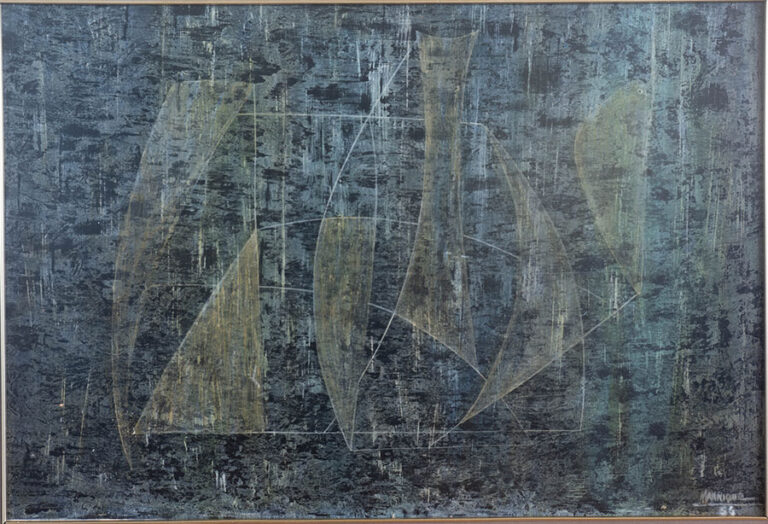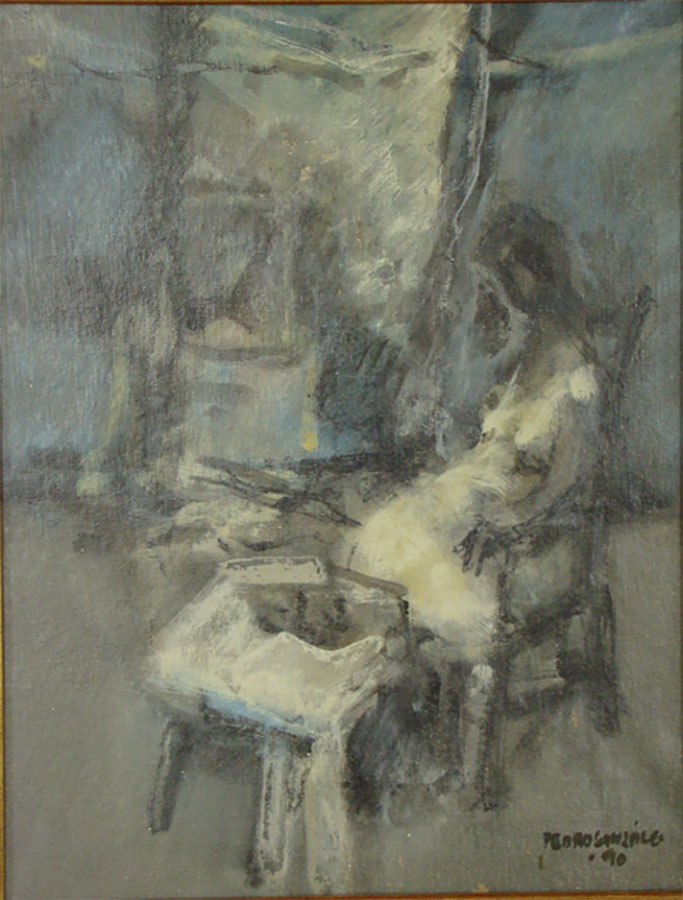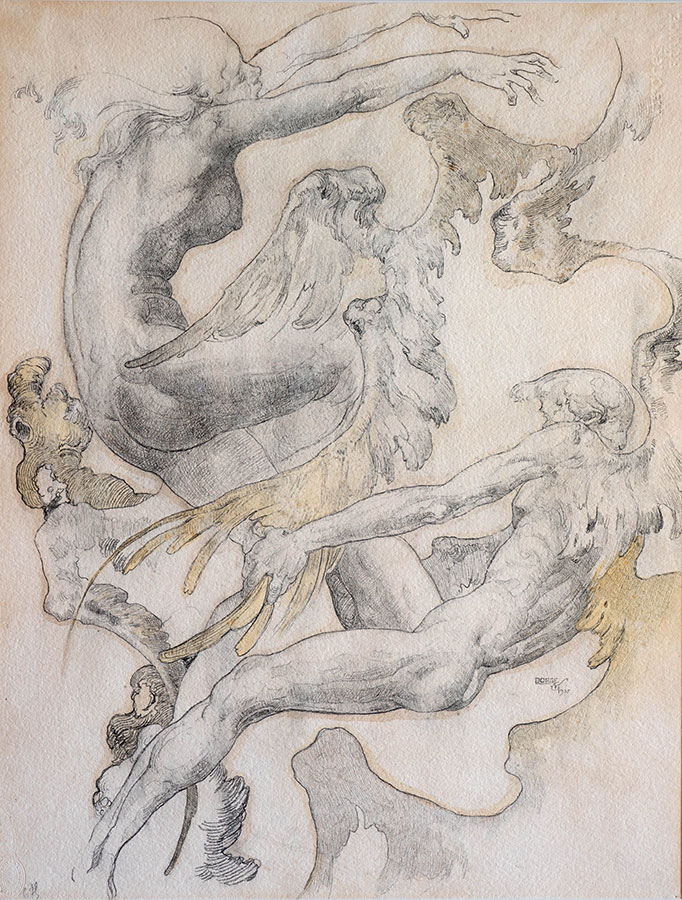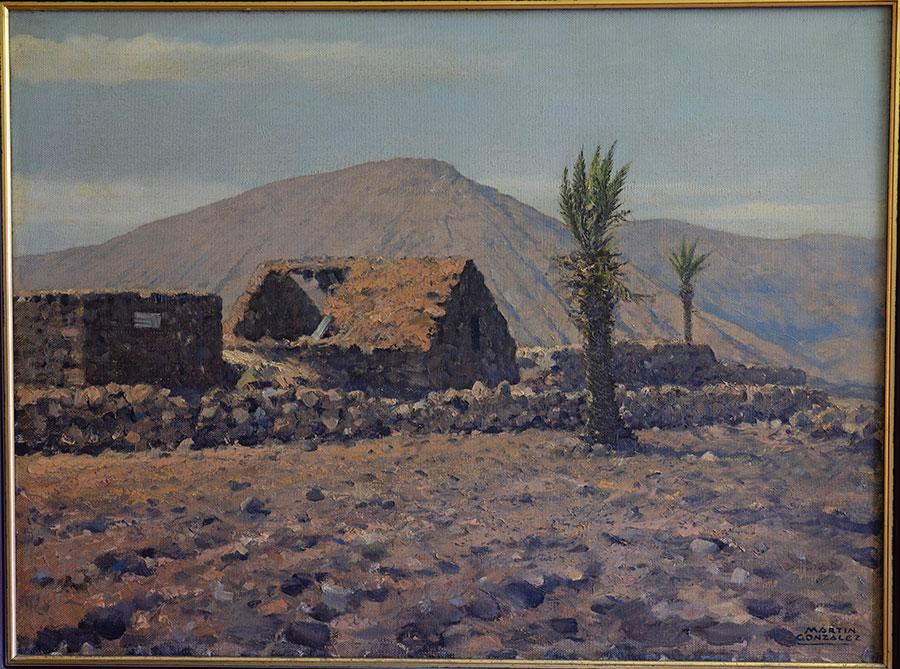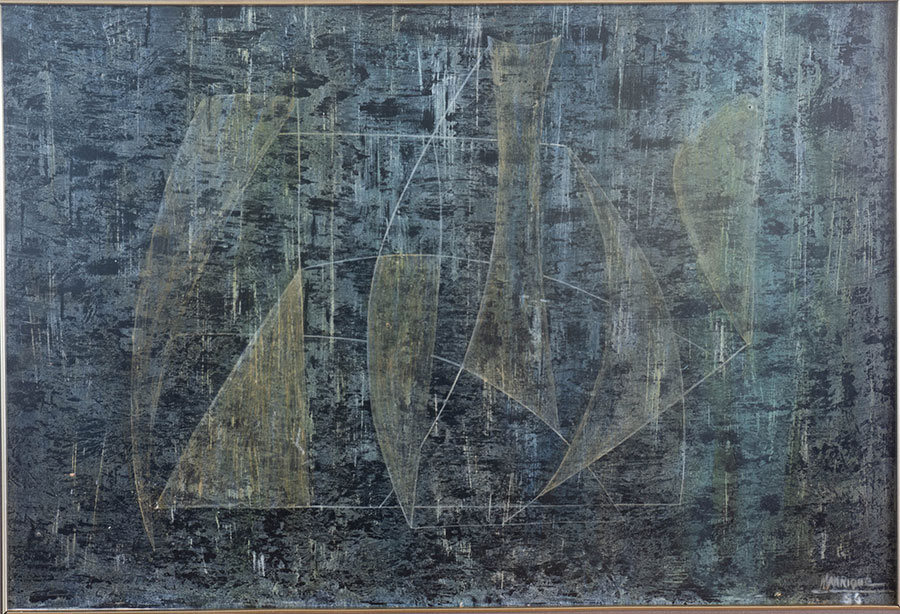
- Type of work: Painting on paper
- Technique: Mixed on cellulosic support (paper)
- Approximate dimensions: 45 x 65 cm
- Theme: Abstraction
- Title: Abstraction II
- Author: César Manrique (1919-1992)
- Chronology or Year: 1956
- Historical-artistic analysis:
Style: abstract painting corresponding to the second stage of Manrique’s production (1954-1957).
Description: It is a painting contained within geometric schemes in the form of triangles or ellipses, a language of secret signs attached to a surface covered with a very sober and austere range of color that, in shades of gray and black, floods the space, with certain roughness that highlights the ocher of the geometric shapes.
Date of reception: In 1957 it was acquired by the Casino.
Observations: It was probably one of the 24 paintings that together with a mural sketch were part of the artist’s solo show, held at the Casino of Santa Cruz de Tenerife in 1957. For the decoration of the new summer terrace, the Casino had previously commissioned a mural. In that year the Casino bought the five paintings, which also decorated that terrace. In support of the abstract will of this period, in the paintings of these years he has replaced the titles by a chronologically correlative numbering.
About the author: César Manrique (Arrecife, Lanzarote, 1919 – Tahíche, Lanzarote, 1992), gifted with a great ability for drawing, his initial training is self-taught, influenced by the observation of the craft activity, then abundant in Puerto Naos, the work of Picasso, Matisse and Braque, known through magazines, contact with the Millares family when he moved to Lanzarote in 1936 and friendship with the sculptor Pancho Lasso from 1939. After a solo exhibition in 1942 and participation in the collective exhibition of artists from the province of Las Palmas de Gran Canaria at the National Museum of Modern Art in 1944, he obtained a scholarship from the General Captaincy of the Canary Islands to continue his studies in Madrid at the Academia de Bellas Artes de San Fernando under Vázquez Díaz and Eduardo de Chicharro, where he remained between 1945 and 1950. In this first stage of his production (1945-1954), the insular imaginary, with which he had already established a full identification, moves away from naturalism in search of the synthesis and essence of reality with a plastic language influenced by Picasso in drawing and Matisse in color. Replacing figurative references with secret signs, a series of monotypes exhibited in 1954 at the Clan Gallery in Madrid places him within the group of artists with avant-garde ideas for the renovation of Spanish art after the Civil War. More than the content, the procedure used now stands out, with exclusive use of plastic elements, where in a pro-constructivist conception the line traces geometric shapes, treating color as the most significant element of the work. His stay in Paris in 1953, where he carries out research on non-figurative painting. leads him to a second stage of austerity (1954 – 1957), where there is a break with color and matter within geometric schemes begins to become the main element supporting the expressiveness of the painting. This process of investigation of matter and forms leads to a stage of maturity that begins in 1958 when geometric schemes disappear and it is the matter that only assumes the significance of the painting, which also recovers the previous color as part of its nature. His work, shown in individual exhibitions at the Clan Gallery in Madrid, soon achieved recognition crystallized in the 2nd Medal of the 1st Contemporary Art Exhibition in Cartagena, and in his participation in the XXVIII Venice Biennial and in the III Hispano-American Biennial in Havana in 1955. That year he was commissioned to decorate the Hotel Fénix in Madrid, thus continuing with the muralist activity begun in 1950 in the Parador de Turismo de Arrecife and in other companies such as the Banco Guipuzcoano de Santander (1955), in the Barajas Airport or the mural commissioned by the Casino de Tenerife in 1957, the year in which he exhibited his work in that society, highly praised by the critics, who considered him the most decorative “abstractionist” of the moment. In 1960 his work had already been shown in the main European art centers, continuing with his solo exhibitions in Madrid and Paris and participating again in the Venice Biennale. In 1964 he travels to New York at the invitation of Nelson Rockefeller, settling in that city the following year with a scholarship from the New York International Institute of Education for the study of American art. His contact with New York’s cultural life and with American artistic currents – abstract expressionism, pop, kinetic art – was of great importance for all his creative facets, not only for painting, but also for sculpture, murals and spatial interventions. Hired exclusively by the prestigious Catherine Viviano Gallery, where he exhibited three times, in his paintings he uses action painting techniques (dripping, calligraphic signs, gestural splashes) and they begin to receive names of places or geographical features of Lanzarote as a reinforcement of its abstract character, as they are subject to any interpretation. Despite the frenetic cultural activity offered by New York, a spiritual need and the ever-present presence of Lanzarote in his memory forced him to return and take up permanent residence on the island. He then began his work of intervention in the space of his island, threatened at that time by the tourist avalanche. Aware of the importance of incorporating Lanzarote in the development of this sector but without despoiling its natural landscape, its main source of wealth, he had the ability to incorporate in the same company the production of elements for tourism consumption and the conservation of the landscape, creating a model image of identification of man with the environment. For this work, which had the unconditional support of the Island Council, he won the World Prize for Ecology and Tourism in Berlin (1978), the Europa Nostra Award (1980) and the declaration of Lanzarote as a World Biosphere Reserve by UNESCO in 1993. His interest in urban planning and architecture, already evident in his association with architects for the decoration of murals, led him to rescue the cultural and natural values of the island and to design an itinerary that would regulate the use and enjoyment of the landscape, providing it with spaces for its contemplation, such as Jameos del Agua, Mirador del Río, Taro de Tahíche, or La Peña in El Hierro, with a perfect synthesis of local tradition and modernity in harmony with the environment. That ideology he called art-nature/nature-art and his fight against the degradation of the coastline explains his intervention in Costa Martiánez in 1970, Playa Jardín in 1990 or in the Hotel Salinas and La Vaguada in 1983, without ever abandoning his facet as a painter. From the sixties onwards, color recovers the intensity of previous periods and at the end of the seventies he incorporates figurative and allegorical references, his paintings always open to diverse expressive possibilities, as is also the case with his sculptures, most of them designed for his spatial interventions. His art, which integrates all his creative potential, was always at the service of life, cut short by a traffic accident in September 1992.
Bibliography:
Archive of the Casino de Tenerife. Minutes J.D. June 6, 1957.
Valeriano WEYLER: The small history of a great casino (The one in Santa Cruz de Tenerife). Santa Cruz de Tenerife, 1964.
Agustín GUIMERÁ RAVINA, Alberto DARIAS PRÍNCIPE: El Casino de Tenerife 1840 – 1990, Santa Cruz de Tenerife, 1992.
Fernando RUIZ GORDILLO: César Manrique, César Manrique Foundation, Madrid, 1998 (4th edition).
Lázaro SANTANA: Manrique. Art of the Canary Islands Edirca, Las Palmas de Gran Canaria, 1991 Lázaro SANTANA: César Manrique. An art for life. Barcelona 1993

